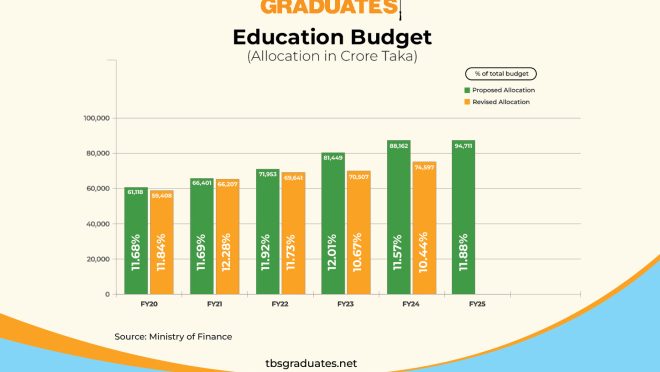Allocation for education increased, but is it enough?
Allocation for education increased, but is it enough?

Although spending on education increased, it still seems like the sector has taken a backseat in the budget, despite getting the third highest allocation.
According to the proposed national budget for FY25, the spending on education is set at Tk94,711 crore, which is higher than last year’s proposed expenditure of Tk74,597 crore.
The latest figure constitutes 11.9% of the total budget, but it still remains 1.7% of the Gross Domestic Product (GDP).
The education budget has been languishing below 2% of GDP for the last two decades.
Finance Minister Abul Hassan Mahmood Ali unveiled the Tk7.97 lakh crore proposed national budget for the fiscal year 2024-25 today (6 June).
In FY2024-25, a total of Tk44,108 crore was proposed for the secondary and higher education sector, which was Tk42,839 crore in FY2023-24.
For Technical and Madrasa Education Division, the allocation stood at Tk11,783 crore in FY2024-25, which was Tk10,602 crore in FY2023-24.
The meagre allocation stands in stark contrast to the Education 2030 Framework for Action, adopted by UNESCO Member States in 2015, which urges governments to allocate at least 4–6% of their GDP to education.
When it comes to education spending among South Asian nations, Bangladesh is ahead of only Sri Lanka in allocation.
The latest World Bank data reveals that Bhutan leads the region, investing 8.14% of GDP in education in 2022.
This is followed by the Maldives (4.58%), Nepal (3.65%) and Pakistan (1.97%). In 2021, India earmarked 4.64% of GDP for education, while Afghanistan allocated 4.34% in 2017.
Meanwhile, Sri Lanka allocated 1.20% in 2022.
To achieve four education-related targets of UN sustainable development goals by 2030, Bangladesh has to ensure universal, quality, equitable and inclusive education up to secondary level as well as create opportunity for further education–which are equally crucial for achieving national strategic goals such as reaching middle-income country threshold by 2031 and developed country by 2041.


